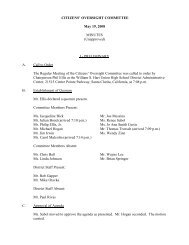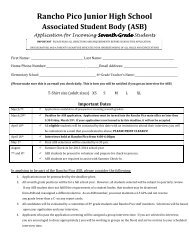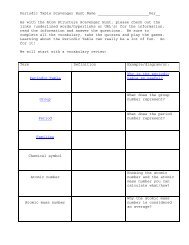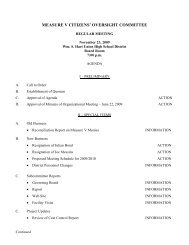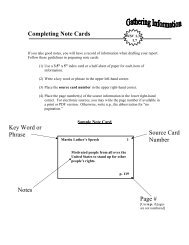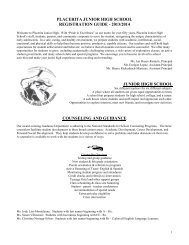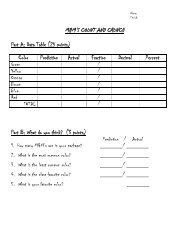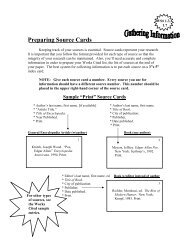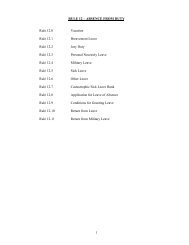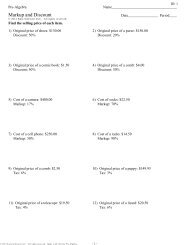Safe School Plan - William S. Hart Union High School District
Safe School Plan - William S. Hart Union High School District
Safe School Plan - William S. Hart Union High School District
Create successful ePaper yourself
Turn your PDF publications into a flip-book with our unique Google optimized e-Paper software.
INCIDENT: HAZMAT (Hazard Materials)<br />
<br />
<br />
<br />
<br />
<br />
<br />
Immediately after a HAZMAT condition has been reported to an administrator, the administrator will call either the fire department<br />
or the Sheriff’s Station and insist that one of their personnel report to the school ASAP to confirm the call. If the school deputy is<br />
available, s/he may confirm the call.<br />
After a proper authority has confirmed the call, the principal will conduct a meeting with selected members of the Crisis Team. The<br />
purpose of the meeting will be to 1) define the situation, 2) discuss possible solutions/actions, 3) define the plan of action, and 4)<br />
execute the plan.<br />
The principal will contact the district superintendent and apprise him/her of the situation.<br />
If the administration is instructed to evacuate the school premises, the plan of action must include the manner of dismissal, i.e., all at<br />
once, by building(s), or etc., the route(s) that will be used, and the designated assembly area.<br />
Communications will remain a high priority during the entire situation. The Crisis Team must also insure that appropriate<br />
information is being disseminated effectively, and supervision of all personnel is being conducted responsibly.<br />
The administrator in charge will activate the Recording Team and instruct its selected members to record all occurrences, decisions,<br />
and results chronologically.<br />
INCIDENT: BULLYING<br />
“Bullying is commonly defined as intentional, repeated hurtful acts, words or other behavior, such as name-calling, threatening and/or<br />
shunning committed by one or more children against another. These negative acts are not intentionally provoked by the victims, and for such<br />
acts to be defined as bullying, an imbalance in real or perceived power must exist between the bully and the victim.” 7 There are many forms<br />
of bullying: physical, psychological, emotional, sexual, cyber, etc. Acts of bullying may include pushing, punching, tripping, name-calling,<br />
rejecting, terrorizing, extorting, humiliating, sexual harassment, sexual assault, electronically communicating insults, threats, or suggestions<br />
that others mistreat a target, and the list goes on.<br />
At the minimum, bullying involves an aggressor and a target. It is immediately clear how the target is hurt. However, the aggressor is also<br />
hurt in this action. The target will suffer some form of pain from the action, which most often will transition to anger. Also, the target<br />
experiences fear and doesn’t feel safe in the school environment. Those feelings will affect the target’s ability to perform at his/her best in<br />
academics. The aggressor is often affected by reputation of being someone who is mean and insensitive. This will limit the aggressor’s<br />
social contacts and stain his/her character by being a person, who mistreats others at will.<br />
ADDRESSING THE PROBLEM<br />
According to the federal Department of Education pamphlet, Preventing Bullying: A Manual for <strong>School</strong>s and Communities, it takes the<br />
collective effort of administrators, teachers, counselors, students and parents to effectively address and prevent bullying. This pamphlet<br />
shares that the Center for the Study and Prevention of Violence uses the model of researcher, Dan Olweus. Mr. Olweus’ model includes<br />
school-level interventions, classroom activities, individual interventions, and community activities. Other good sources of information are<br />
WiredKids, Inc. and the research and publications by Sameer Hinduja, Ph.D. and Justin W. Patchin, Ph.D.<br />
When an incident of bullying is reported or observed, the incident is to be thoroughly investigated. 8 If needed, the resource deputy will be<br />
consulted and possibly brought in to handle the incident. Upon completion of the investigation of the incident, the appropriate action is to<br />
occur for both the target and the aggressor. Parents of both parties are to be contacted and notified of their child’s part in the incident, as well<br />
as the actions taken to address their child’s part in the incident.<br />
7 United States of America Department of Education. Preventing Bullying: A Manual for <strong>School</strong>s and Communities. Pamphlet: 1.<br />
8 Sameer Hinduja and Justin W. Patchin. Preventing Cyberbullying: Top Ten Tips for Educators. Internet: www.cyberbullying.us 2009.<br />
90





